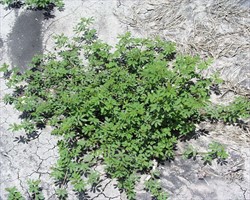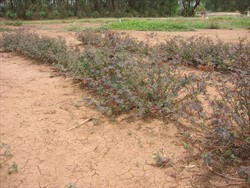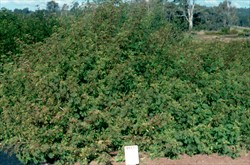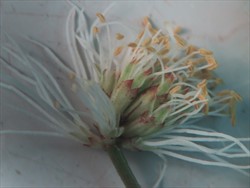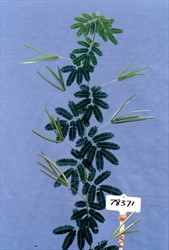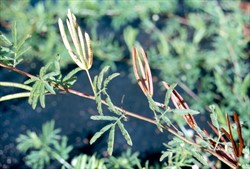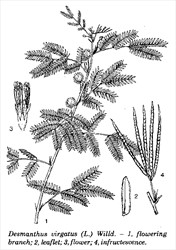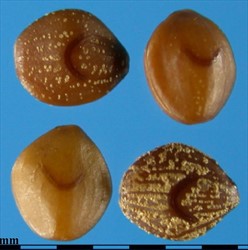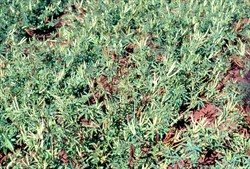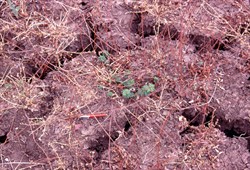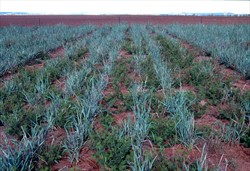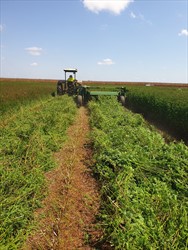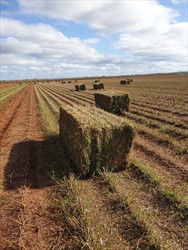Desmanthus virgatus
Tropical Forages
Desmanthus virgatus (L.) Willd.
Note: Turner (1950) regarded Desmanthus virgatus as an all-encompassing species, comprising D. virgatus , D. pubescens , D. pernambucanus, D. glandulosus and D. leptophyllus. Despite taxonomic revision by Luckow (1993) resolving the complex to distinct species, identity within the complex is sometimes still confused, the most common example being with the widely sown D. pernambucanus.
Basionym: Mimosa virgata L.; Desmanthus depressus Humb. & Bonpl. ex Willd.; Desmanthus virgatus var. depressus (Humb. & Bonpl. ex Willd.) B.L. Turner
Family: Fabaceae (alt. Leguminosae) subfamily: Caesalpinioideae (mimosoid clade*) tribe: Mimoseae.
* Azani, N. et al. [97 authors from 54 institutions] 2017. A new subfamily classification of the Leguminosae based on a taxonomically comprehensive phylogeny. Taxon 66: 44–77.
Prostrate, decumbent or erect sufruticose perennial, typically to 0.7 m, occasionally to 1.5 m tall; much branched from the base, with a taproot to 50 cm long and 1–2 cm in diameter. Young stems angled, green with red or gold corky ridges, glabrous or sparsely pubescent with white hairs; older stems terete, red or brown, glabrous and shiny. Stipules persistent, 2–9 mm long, setiform, with a membranous nerved auricle opposite the petiole. Leaf paribipinnate, 2.4–8.0 cm long, petiole 1–5 mm long, rachis 7–36 mm long, puberulent; pinnae 2–5 pairs 11–30 mm long, an orbicular, sessile, crateriform nectary inserted between the lowermost pair; pinnules 11–23 pairs, nearly sessile, 2.4–7.0 mm long and 0.7–1.6 mm wide, linear-oblong, glabrous, finely ciliate along the margin with white hairs. Capitulum (flower head) 0.3–1.0 cm long, borne singly in leaf axil on peduncle 0.6–4.0 cm long; heads contain 3–22 perfect, functionally male or sterile flowers; 0–8 sterile flowers at the base of the head; 0 (–1) male flowers towards the base of the head above the sterile flowers, and below the perfect flowers; perfect flowers 3–14 apical. Fruiting peduncles 1.0–5.2 cm long bear 1–11 pods; pods (2.2 –) 5.5–8.8 cm long, 2.5–4.9 mm wide, linear, straight or slightly falcate, tip acute, rairly attenuate into a beak to 1 mm; reddish-brown to nearly black at maturity, opening along both margins. Seeds 9–27 per pod, 2.1–3.1 × 1.4–2.7 mm, flattened, ovate, reddish-brown or golden-brown. 250,000–350,000 seeds/kg.
Similar species
Desmanthus virgatus: prostrate, decumbent or erect subshrubs, typically to 1.5 m tall; petioles of mature leaves 1–5 mm long; pinnae 2–5 pairs (nectary between lowermost pair); pinnules 11–23 pairs.
Desmanthus glandulosus: erect or occasionally decumbent perennial herb to 0.7 m tall; petiole of mature leaves 4‒10 mm long; pinnae 3‒6 pairs (multiple nectaries common); pinnules 14–26 pairs.
Desmanthus leptophyllus: erect (rarely prostrate or decumbent) shrub 0.4–3 m tall; petioles of mature leaves 3–14 mm long; pinnae 4–8 pairs (nectary between lowermost pair); pinnules 16–36 pairs.
Desmanthus pernambucanus: erect to decumbent perennial herbs/subshrubs, mostly 0.5–2 m tall; petioles of mature leaves 6–16 mm long; pinnae 2–4 pairs (nectary between lowermost pair); pinnules 9–21 pairs.
Asia: 多枝草合歡, 合欢草 (China); ヒメギンネム (Japan)
English: desmanthus (used for all members of the genus), ground tamarind (probably D. pernambucanus); dwarf koa (Hawaii); rayado bundleflower (possibly D. bicornutus), virgate bundleflower, virgate mimosa, wild tantan
French: koa nain, langalet, petit acacia, petit cassie, petit mimosa, pompon blanc
Latin America: angiquinho, anis-de-bode, canela-de-ema, junco-preto, jureminha, pena-da-saracura, vergalho-de-vaqueiro(Brazil); brusca prieta, desmanto, huizachillo (all appear to be genetic); espinillo rastrero, modestancia, yucarí niná, yuquerí-pí, yvá-carininá (Argentina); adormidera, morivivi hembra (Cuba); brusca prieta, dwarf koa, frijolillo, guajillo (Oaxaca, Mexico), guashillo (Puebla, Mexico); huarangillo (Peru); mimosa-pequeña
Note: As commented in "Scientific name", there has been considerable confusion regarding plant identity within the D. virgatus complex. Because of the broad similarity among many members of the genus, this same confusion extends to common names. The same common name is often applied not only to other Desmanthus spp., but also to other pinnate-leaved, not necessarily mimosoid, species (e.g. angiquinho is also used to refer to Acacia, Aeschynomene, Calliandra, Mimosa and Sesbania spp.).
Native:
Northern America: Mexico (Campeche, Chiapas, Chihuahua, Coahuila, Colima, Durango, Guerrero, Hidalgo, Michoacán, Nuevo León, Oaxaca, Puebla, Quintana Roo, San Luis Potosí, Tabasco, Tamaulipas, Veracruz, Yucatá); USA (Texas)
Caribbean: Anguilla; Antigua and Barbuda (Antigua); Aruba; Bahamas; Barbados; BritishVirgin Islands (Tortola); Cuba; Dominica; Dominican Republic; Grenada; Guadeloupe; Haiti; Jamaica; Martinique; Montserrat; Netherlands Antilles (Bonaire, Curacao); Puerto Rico; St. Kitts and Nevis (St. Kitts); St. Lucia; St. Vincent and Grenadines; Trinidad and Tobago; U.S Virgin Islands
Central America: Belize; Costa Rica; El Salvador; Guatemala; Honduras; Nicaragua
South America: Argentina (Corrientes, Entre Ríos, Jujuy, Salta); Bolivia; Brazil (Rio Grande do Sul); Chile; Colombia; Ecuador; French Guiana; Guyana; Paraguay; Peru; Suriname; Uruguay; Venezuela
Naturalized:
No record
Cultivated:
GRIN lists D. virgatus as being cultivated in Mauritius, India, and Hawaii, the same countries where D. pernambucanus is cultivated or naturalized. It is probable this is another example of the confusion from the earlier taxonomic treatment of the D. virgatus complex.
Forage
Grazed by herbivores in the native range. Component of improved permanent pastures in northern Australia. Can be used for hay, but requires rapid drying to avoid significant leaf drop. Good levels of leaf retention have been achieved by cutting the crop with a mower-conditioner and not raking or turning the cut material prior to baling (see images).
Environment
While it is often claimed that D. virgatus is used in hedgerows in alley farming systems in India and Thailand, this is more likely a reference to its generally taller relative, D. pernambucanus.
Soil requirements
D. virgatus has been collected over a wide range of soil textures, from gravelly soils and sands, through loams to heavy clays, the main characteristic in common being that the soils are mainly neutral to alkaline in soil reaction. Highest pH at collection sites in the Australian collection is pH 9, the lowest pH 5.5, and the mean pH 7.3. At least some of the soils were saline. The species has shown promise for use on neutral to alkaline cracking clay soils outside its native habitat, and may well have potential in areas with developing salinity.
Moisture
Lowest average annual rainfall at collection sites was 230 mm, the highest 1600 mm, and the average 790 mm (SD 320 mm). Well-adapted to 550‒1,000 mm average rainfall environments in exotic locations. In low-rainfall (300‒400 mm/year), drought prone environments in northern Australia, D. virgatus was one of the very few species that persisted under grazing over a 14 year period.
Temperature
Occurs over a wide temperature range from coastal to sub-montane environments and from the equator to 31° N in Texas, USA to 33° S in Río Negro Department, Uruguay, representing an average annual temperature range from about 17 °C to 27 °C, and including environments receiving regular frosts. While lines tested are defoliated by heavy frosts, they regrow from crowns in spring given adequate moisture.
Light
Poorly adapted to reduced light conditions, surviving but producing little dry matter under moderate shade, but dying out under more intense shade.
Reproductive development
Produces flowers and fruit year-round in the tropics, given sufficient soil moisture, and predominantly spring and early summer in the subtropics, although can be any time when moisture and temperature suitable. In the monsoonal upland tropics, flowering and fruiting appear to be largely controlled by moisture and temperature.
Defoliation
Very tolerant of regular cutting and grazing by ruminants.
Fire
Regrows from the crown after moderate fire. Fire can be useful in breaking seed dormancy, germination of D. virgatus seed buried at 0.5‒3.0 cm and subjected to temperatures commonly occurring in grass fires increasing by up to 60%. Grass fire temperatures kill seed located on the soil surface.
Guidelines for establishment and management of sown forages.
Establishment
Sow 2 kg/ha of scarified seed at a depth of 0.5‒2.0 cm into moist soil with at least 50‒60 cm depth of good moist soil to ensure establishment. Deeper planting depths may prevent or delay emergence. Surface broadcasting onto a well-prepared seed-bed, followed by rolling; planting using a "crocodile" seeder; sod-seeding into slashed back pasture treated with glyphosate to suppress grass growth; or planting into cultivated strips; have also given satisfactory results. Fresh seed is extremely hard-seeded and should be scarified, either abrasively (e.g. using a rice polisher) or by hot water treatment (4‒10 seconds in boiling water), to raise the germination to a minimum of 50‒70%. While it is desirable to achieve good establishment from the initial sowing, it can be an advantage to sow a proportion of hard seed that can germinate with subsequent rainfall events in case of catastrophic loss of the initial stand. Hard seed can remain dormant in the soil for 5 or 6 years. Although Desmanthus spp. are not highly specific in their rhizobial demands and may nodulate effectively on native rhizobia, it may be advantageous to inoculate seed with a known effective strain of rhizobium such as CB 3126 recommended in Australia. The presence of native Neptunia spp., a genus closely related to Desmanthus, may indicate presence of an effective rhizobial strain. Recruitment from seed produced in grass-legume pastures does not occur until hardseededness has been overcome by weathering. This may take some years since the half-life for breakdown of hard seed has been determined to be 60‒70 months under field conditions.
Fertilizer
May respond to S, Mo, P, Cu and Mn on neutral to alkaline dark clay soils, particularly those formed on basalt. Plants suffering from poor nodulation, sulfur deficiency and molybdenum deficiency all exhibit poor growth and yellowing of the leaves (chlorosis). Use of an effective strain of rhizobium (e.g. CB 3126) ensures good nodulation. Sulfur deficiency is not always diagnosable from soil test, but tissue analysis may assist. A critical leaf tissue concentration of 0.2% S is required for optimum productivity. In the absence of tissue test, application of sulfate (gypsum, superphosphate) to deliver 20 kg S/ha in a test strip should indicate adequacy or deficiency. Molybdenum at 100 g/ha as sodium molybdate (soluble, 300 g/ha) or molybdenum trioxide (insoluble, 150 g/ha) is usually sufficient to overcome Mo deficiency. Phosphorus should be applied as indicated by soil test, or at 20‒30 kg/ha.
Compatibility (with other species)
In northern Australia, cv. Marc has persisted and increased in buffel grass (Cenchrus ciliaris) pastures and in pastures dominated by Queensland bluegrass (Dichanthium sericeum). Recruitment from high soil seed levels is irregular but successful in favourable seasons.
Companion species
Grasses: Cenchrus ciliaris, Dichanthium sericeum, Panicum coloratum var. makarikariense
Legumes: Clitoria ternatea, other Desmanthus spp., Medicago sativa
Pests and diseases
Occasional, minor damage by psyllid insects (Acizzia spp.) was reported in northern Australia. The psyllids cause more serious damage in seed crops. Several seed-eating bruchid beetles (5 Acanthoscelides spp. and 1 Stator sp.) are known to infest Desmanthus. Recorded as a host for alfalfa mosaic virus.
Ability to spread
Being early flowering and producing large seed crops, D. virgatus has the potential to spread under grazing given reasonable rainfall conditions.
Weed potential
Has potential to become a minor weed of disturbed areas. Its low growth habit limits its ability to dominate companion species.
Nutritive value
Nutritive value of the various species of Desmanthus evaluated have been largely similar based on laboratory testing. Crude protein concentration of the entire plant ranges from 10.5 to 15.5%, with leaves averaging 22.4% and stems 7.1%. A study of 18 accessions grown in India reported an average CP of 21% (range 15‒27%), and average NDF and ADF concentrations of 42 and 35%, respectively. In sacco DMD and N concentration of CPI 78382 were 65% and 3.5%, respectively.
Palatability/acceptability
Palatable to grazing ruminants and grazed by beef cattle throughout the growing season. Desmanthus has been observed to be less palatable than leucaena (Leucaena leucocephala) but more readily eaten than Stylosanthes scabra cv. Seca.
Toxicity
No toxicities to ruminant livestock were reported in the literature. Desmanthus spp. do not cause bloat in ruminants because they contain 2‒3% (of total DM as tannic acid equivalent) condensed tannins.
Feedipedia link
Dry matter
The relative contribution of D. virgatus to pasture yield increases with the severity of the environment, so that it has the potential to be more valuable on soils of at least moderate fertility in sub-humid, seasonally dry environments. In more testing environments, its relative contribution to pasture yield can be significant, whereas in highly favourable environments, other legume species may make a greater contribution to yield. While D. virgatus has produced 7.6 t/ha DM in the humid tropics and 7.1 t/ha DM under irrigation in a sub-humid environment, yields of 2.0‒2.4 t/ha/year DM in rain-fed, 600‒750 mm rainfall environments are more common. Presentation yields of D. virgatus CPI 78382 and cv. Marc in grazed pastures in Australia ranged from 100 to 600 kg/ha DM over 6 below-average rainfall years and contributed between 3 and 20% of total DM yield.
Animal production
In a pen feeding experiment where a Mitchell grass (Astrebla spp.) basal diet was supplemented with D. virgatus accessions CPI 78382 and CPI 79653, DM intake of Merino wethers increased from 580 to 752 and 753 g/head/day, respectively, and wool growth increased from 0.48 to 0.69 and 0.73 g/day/cm², respectively. Inclusion of Desmanthus spp. in mixed grass legume pastures has been shown to improve liveweight gain in cattle. Steers on a mixed buffel grass (Cenchrus ciliaris) - Desmanthus pasture gained 40 kg/head over the 90 day cool/dry season, while those on buffel grass alone had a net gain of 10 kg/head.
Taxonomic confusion within the genus has led to D. pernambucanus, D. leptophyllus, D. pubescens and D. virgatus all being evaluated as D. virgatus. However, there is considerable genetic and morphological diversity within D. virgatus that may have potential for cultivar development. Genotypes from the northern Caribbean are very different from provenances from Mexico, which in turn are different from those in Argentina. D. virgatus germplasm has been evaluated for agronomic potential in India, southern USA and northern Australia. Considerable intraspecific hybridization has been observed in nursery plots where a number of accessions are grown in fairly close proximity. Persistent types have been selected from discontinued evaluation sites. Current work looking at interspecific hybrids between D. virgatus and D. leptophyllus and D. bicornutus is producing promising results. Chromosome number 2n = 28.
D. virgatus accessions have proven to be prolific, early seed producers. Seed yields of 400‒500 kg/ha are achieved from direct-headed crops, despite considerable seed losses occur due to uneven ripening and early seed fall. The potential seed yield using a suction harvester is in excess of 1,000 kg/ha, although the suction required to collect the small, dense Desmanthus seed can result in large quantities of small stones in the sample. A native psyllid insect (Acizzia spp.
D. virgatus seedlings are susceptible to the various hormone type herbicides such as 2,4-D, 2,4-DB, dicamba, MCPA and MCPB. The main role of herbicides with this species is in seed production.
- Combines well with grass pastures in sub-humid moderate fertility environments.
- Tolerant of heavy grazing.
- Very persistent in low rainfall environments.
- Tolerant of alkaline, sodic, saline and heavy clay soils.
- High rates of seed production.
- Recruitment in the years following planting is limited by hardseededness.
- Relatively low DM productivity in vigorous grass pastures.
- Limited potential as a ley legume species due to low DM yields, high seed yields and early seed production.
- Seed may need inoculating with effective rhizobium strain.
Burt, R.L. (1993) Desmanthus: a tropical and subtropical forage legume. Part 1. General Review. Herbage Abstracts 63:401–413.
Burt, R.L. (2016) Searching for pasture legumes for heavy clay soils in Australian dry tropics and subtropics: IV. Evaluation in Western Queensland. In: Lazier, J.R. and Ahmad, N. (eds) Tropical forage legumes: Harnessing the potential of Desmanthus and other genera for heavy clay soils. CAB International, Wallingford, Oxon, UK. p. 204–253. doi.org/10.1079/9781780646282.0204
Clem, R.L. and Cook, B.G. (2004) Identification and development of forage species for long-term pasture leys for the southern speargrass region of Queensland. In: Whitbread, A.M. and Pengelly, B.C. (eds) Tropical legumes for sustainable farming systems in southern Africa and Australia. ACIAR Proceedings No. 115. Australian Centre for International Agricultural Research (ACIAR), Canberra, Australia. p. 64–79. aciar.gov.au/node/8436
Cox, K.G. and Harrington, K.C. (2005) Selective herbicide strategies for use in Australian Desmanthus seed crops. Tropical Grasslands 39:171–181. bit.ly/2WNQC7G
Gardiner, C.P. (2016) Developing and commercializing new pasture legumes for clay soils in the semi-arid rangelands of northern Australia. In: Lazier, J.R. and Ahmad, N. (eds) Tropical forage legumes: Harnessing the potential of Desmanthus and other genera for heavy clay soils. CAB International, Wallingford, Oxon, UK. p. 283–304. doi.org/10.1079/9781780646282.0283
Gardiner, C.P., Ossiya, S.A. and Rangel, J.H.A. (2017) Discontinued legume trials yield potentially valuable genotypes. Proceedings of the 18th Australian Society of Agronomy Conference. Ballarat, Australia, 24–28 September 2017. bit.ly/2JkWv4n
Hopkinson, J.M. and English, B.H. (2004) Germination and hardseededness in Desmanthus. Tropical Grasslands 38:1–16. bit.ly/2wyIPA7
Jones, R.M. and Brandon, N.J. (1998) Persistence and productivity of eight accessions of Desmanthus virgatus under a range of grazing pressures in subtropical Queensland. Tropical Grasslands 32:145–152. bit.ly/39luAvP
Jones, R.M., Bishop, H.G., Clem, R.L., Conway, M.J., Cook, B.G., Moore, K. and Pengelly, B.C. (2000) Measurements of nutritive value of a range of tropical legumes and their use in legume evaluation. Tropical Grasslands 34:78–90. bit.ly/2WMzAqx
Luckow, M. (1993) Monograph of Desmanthus (Leguminosae-Mimosoideae). Systematic Botany Monographs Vol. 38. American Society of Plant Taxonomists, Laramie, WY, USA. doi.org/10.2307/25027822
Pengelly, B.C. and Liu, C.J. (2001) Genetic relationships and variation in the tropical mimosoid legume Desmanthus assessed by random amplified polymorphic DNA. Genetic Resources and Crop Evolution 48:93–101. doi.org/10.1023/A:1011234913710
Pengelly, B.C. and Topark-Ngarm, A. (1992) Desmanthus virgatus (L.) Willd. In: Mannetje, L.’t and Jones, R.M. (eds) Plant Resources of South-East Asia No. 4. Forages. Pudoc Scientific Publishers, Wageningen, the Netherlands. p. 105–106. edepot.wur.nl/327785
Singh S., Negi, A.S., Agarwal, D.K., Katiyar, P.K. and Singh, U.P. (2000) Chemical composition, in vitro dry matter digestibility, total phenolics and proanthocyanidins in bedge lucerne (Desmanthus virgatus ) exotic germplasm. Indian Journal of Animal Sciences 70:1246–1249. bit.ly/2JlBSF7
Spiers, P.R., Brandon, N.J., Date, R.A., Bahnisch, L.M. and George, D. (1998) Nutrient limitations of clay soils for Desmanthus virgatus. II. A glasshouse study of 7 soils. Tropical Grasslands 32:6–12. bit.ly/2JjDL54
Stuart, P.N. and Kemp, N. (2017) Intraspecific and interspecific crossing of Desmanthus yields new and novel plants. Proceedings of the 18th Australian Society of Agronomy Conference. Ballarat, Australia, 24–28 September 2017. bit.ly/2vUPPqB
'JCU 2' Granted PBR protection in Queensland, Australia (2015) Derived from a selected plant (putative parent CPI 91335: origin Oaxaca, Mexico. 16°19' N, 10 m asl, rainfall 960 mm) growing in a mixed sward of Desmanthus spp. outside of an old trial planting at "Wrotham Park" near Chillagoe, Queensland (17°09' S, rainfall 850 mm). Selected on the basis of its persistence under grazing and plant density relative to known Desmanthus cultivars. The progeny of the originally selected plant have undergone a further 5 generations of selection for visual genetic uniformity prior to release.
'JCU 3' Granted PBR protection in Queensland, Australia (2015). Derived from a selected plant (putative parent CPI 57960: origin Curaçao, Lesser Antilles, 12°07' N, rainfall 570 mm) growing in a mixed sward of Desmanthus spp. from an old trial planting on "Taranaway Station", Isisford, Queensland (24°15' S, rainfall 450 mm). Selected on the basis of its persistence under grazing and plant density relative to known Desmanthus cultivars. The progeny of the originally selected plant have undergone a further 5 generations of selection for visual genetic uniformity prior to release.
'JCU 5' Granted PBR protection in Queensland, Australia (2015). ‘JCU5’ derived from a selected plant (putative parent CPI 67643: origin Zacapa, Guatemala, 15°00' N, 185 m asl, rainfall 500 mm) growing in a mixed sward of Desmanthus spp. from an old trial planting on "Woodbine", Blackall, Queensland (24°20' S, rainfall 520 mm). The progeny of the originally selected plant have undergone a further 5 generations of selection for visual genetic uniformity prior to release.
'Marc' (CPI 78373) Granted PBR protection in Queensland, Australia (1992). Origin Salta, Argentina (23°15' S, 300 m asl, rainfall 650 mm). Low growing, spreading, early flowering, cultivar growing to a height of 30‒60 cm. More persistent than D. leptophyllus cv. Bayamo and D. pubescens cv. Uman in permanent pasture systems in northern Australia by virtue of its ability to produce heavy seed crops and recruit from seed. Not suitable as a ley legume because of low growing habit and lower DM production compared with other Desmanthus spp.
'Kakan' Released in Argentina (2012) for use in the Submeridional Lowland Region of Santa Fe, Chaco and Santiago del Estero provinces.
'Xero' (CPI 85177) Released in South Africa around 1995. Does not appear to have been commercialised.
CPI 78372 Selected in Queensland, Australia. Origin Salta, Argentina (23°20' S, 400 m asl, rainfall 680 mm). Short-medium height, similar to cv. Marc. Prolific early seed production, persistent, moderate productivity under heavy grazing during 6 dry years in northern Australia. Also performed strongly in agronomic trials at 8 sites.
CPI 78382 Selected in Queensland, Australia. Origin Jujuy, Argentina (24°12' S, 1,000 m asl, rainfall 700 mm). Long term persistence under grazing in subhumid tropics and subtropics. Similar growth habit to CPI 78372.
CPI 79653 Selected in Queensland, Australia. Origin Guantanamo, Cuba (21°59' N, 5 m asl, rainfall 600 mm). A very prostrate, multi-branched, fine-stemmed form of D. virgatus. Selected on the basis of unique growth form within the Australian collection.
CPI 85178 Selected in Queensland, Australia. Origin Coahuila, Mexico (27°30' N, 220 m asl, rainfall 400 mm). Decumbent/prostrate, grey-leafed. Prolific, early seed production. Persistent and moderate productivity under heavy grazing during 6 dry years in northern Australia; also spreading in Heteropogon contortus grassland on dark clay loam in subtropics.
CPI 91326 Selected in Queensland, Australia. Origin Chiapas, Mexico (16°09' N, 20 m asl, rainfall 1600 mm). Productive and persistent in plot trials at 5 sites in southern and central Queensland. Also showed promise in seasonally dry uplands in Eritrea.
Q 9153 Selected in Queensland, Australia. Origin Tumbes, Peru (3°40' S, 70 m asl, rainfall 175 mm). Initially more erect than other lines, but develops more decumbent growth form under grazing. Distinctive purple-grey foliage. Agronomically similar to 'Marc', but with higher DM yield and palatability to grazing cattle, and a higher proportion of soft seed. Prolific seed set and effective coloniser.
